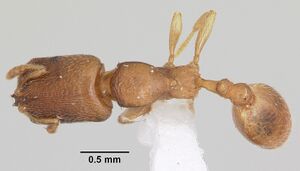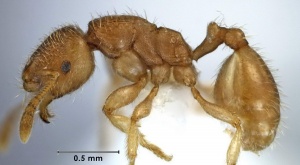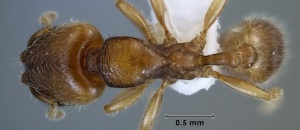Adlerzia froggatti
| Adlerzia froggatti | |
|---|---|

| |
| Adlerzia froggatti front of head, minor worker | |
| Scientific classification | |
| Kingdom: | Animalia |
| Phylum: | Arthropoda |
| Class: | Insecta |
| Order: | Hymenoptera |
| Family: | Formicidae |
| Subfamily: | Myrmicinae |
| Tribe: | Crematogastrini |
| Genus: | Adlerzia |
| Species: | A. froggatti |
| Binomial name | |
| Adlerzia froggatti (Forel, 1902) | |
| Synonyms | |
| |
An infrequently collected species that we known little about. They nest under stones as well as in the soil without coverings.
Identification
The antennae are 11 segmented. The upper surface of the head is smooth and there are no antennal scrobes. The front margin of the clypeus just above the mandibles has pairs of elongate hairs or setae which straddle the mid-line of the head but there are no central hairs. The clypeus has a pair of longitudinal ridges or sharp angles immediately below the antennal sockets which separate the central region from the lateral regions (clypeus longitudinally bicarinate). The petiole has a distinct, rounded node. There are major and minor workers but no intermediates (dimorphic).
These ants are most likely to be confused with species of Pheidole because of the generally similar body size and shape and the presence of major workers. They can be separated by their 11 segmented antennae and bicarinate clypeus.
Keys including this Species
Distribution
Latitudinal Distribution Pattern
Latitudinal Range: -25.91666667° to -35.57693°.
| North Temperate |
North Subtropical |
Tropical | South Subtropical |
South Temperate |
- Source: AntMaps
Distribution based on Regional Taxon Lists
Australasian Region: Australia (type locality).
Distribution based on AntMaps
Distribution based on AntWeb specimens
Check data from AntWeb
Countries Occupied
| Number of countries occupied by this species based on AntWiki Regional Taxon Lists. In general, fewer countries occupied indicates a narrower range, while more countries indicates a more widespread species. |

|
Estimated Abundance
| Relative abundance based on number of AntMaps records per species (this species within the purple bar). Fewer records (to the left) indicates a less abundant/encountered species while more records (to the right) indicates more abundant/encountered species. |

|
Habitat
Known from wet and dry sclerophyll habitats and Eucalypt forest.
Abundance
Infrequently encountered.
Biology
Heterick (2009) - The workers of Adlerzia froggatti include large-headed majors as well as minor and media workers. The presence of large-headed majors suggests that the species may include seeds or similar hard plant material in its diet, but its biology has been scarcely studied. In the SWBP (WA), A. froggatti is rarely encountered, but can be found at localities in the mid-north and south-west of the State, including parts of the Perth metropolitan area that retain tracts of native vegetation. The ant has also been recorded from Westonia in the western goldfields, and Rottnest Island.
Life History Traits
- Mean colony size: ? (Greer et al., 2021)
- Compound colony type: not parasitic (Greer et al., 2021)
- Nest site: hypogaeic (Greer et al., 2021)
- Foraging stratum: subterranean/leaf litter (Greer et al., 2021)
Castes
Adlerzia froggatti has polymorphic workers.
Worker
Minor worker of A. froggatti from New South Wales.
Medium worker of A. froggatti from New South Wales.
Major worker of A. froggatti from New South Wales.
Images from AntWeb
   
| |
| Worker. Specimen code casent0104323. Photographer April Nobile, uploaded by California Academy of Sciences. | Owned by CAS, San Francisco, CA, USA. |
   
| |
| Worker. Specimen code casent0010805. Photographer April Nobile, uploaded by California Academy of Sciences. | Owned by UCDC, Davis, CA, USA. |
Nomenclature
The following information is derived from Barry Bolton's Online Catalogue of the Ants of the World.
- froggatti. Monomorium (Adlerzia) froggatti Forel, 1902h: 445 (w) AUSTRALIA (Victoria).
- Wheeler, G.C. & Wheeler, J. 1977: 583 (l.).
- Combination in Adlerzia: Brown, 1952j: 176.
- Status as species: Emery, 1922e: 182; Brown, 1952a: 110; Brown, 1952j: 176; Taylor & Brown, 1985: 53; Taylor, 1987a: 5; Bolton, 1995b: 58; Heterick, 2009: 144.
- Senior synonym of katerinae: Brown, 1952a: 110; Taylor & Brown, 1985: 53; Taylor, 1987a: 5 Bolton, 1995b: 58.
- Senior synonym of silvestrii: Brown, 1952a: 110; Taylor & Brown, 1985: 53; Taylor, 1987a: 5 Bolton, 1995b: 58.
- katerinae. Stenothorax katerinae McAreavey, 1949: 3, figs. 7-16 (s.w.) AUSTRALIA (Victoria).
- Junior synonym of froggatti: Brown, 1952a: 110; Taylor & Brown, 1985: 53; Taylor, 1987a: 5; Bolton, 1995b: 58.
- silvestrii. Machomyrma silvestrii Emery, 1914b: 182, fig. 2 (s.) AUSTRALIA (South Australia).
- Viehmeyer, 1924b: 311 (w.).
- Status as species: Emery, 1921f: 77; Viehmeyer, 1924b: 311.
- Junior synonym of froggatti: Brown, 1952a: 110; Taylor & Brown, 1985: 53; Taylor, 1987a: 5; Bolton, 1995b: 58.
Type Material
- Stenothorax katerinae: Holotype, worker, Greensborough, Victoria, Australia, Australian National Insect Collection.
- Stenothorax katerinae: Paratype, 2 workers, Greensborough, Victoria, Australia, Australian National Insect Collection.
- Machomyrma silvestrii: Holotype, worker, Mt. Lofty, Adelaide, South Australia, Australia, Museo Civico di Storia Naturale, Genoa.
- Monomorium (Adlerzia) froggatti: Holotype, worker (minor), Bendigo, Victoria, Australia, Musee d'Histoire Naturelle Genève.
Unless otherwise noted the text for the remainder of this section is reported from the publication that includes the original description.
Description
Worker
2,6mm. Mandibules striees, avec le bord terminal grand, oblique, arme de 5 a 7 dents. Epistome largement echancre au milieu de son bord anterieur, fortement imprime en travers derriere lui, avec une forte elevation mediane bicarenee et convexe, mais non bidentee, derriere l'impression. Aire frontale etroite, triangulaire, enfoncee; les aretes frontales formant, un petit lobe arrondi, horizontal de chaque cote d'elle. Tete rectangulaire, un peu plus longue que large, a cotes paralleles et angles posterieurs arrondis. Yeux mediocrement convexes, situes au milieu des cotes. Les scapes assez fortement courbes, courts, un peu dilates vers l'extremite ne depassent guere le tiers posterieur de la tete. Antennes de 11 articles; massue de 3 gros articles, le dernier aussi long que les 2 precedents; articles 2 a 7 du funicule beaucoup plus epais que longs. Dos du promesonotum deprime, subaplati, borde devant, subborde lateralement, suivi d'un segment intermediaire fort etroit et assez distinct, puis d'une faible echancrure meso-metanotale. Face basale subbordee, un peu plus longue que large et un peu plus large derriere que devant, faiblement bituberculee derriere. Face declive oblique, bord'ee de deux faibles aretes, aussi longue que la face basale. Premier noeud du pedicule fort petit; a sommet convexe, avec un petiole anterieur tres long et assez large (surtout assez haut). Second noeud arrondi, a peine plus large que long. Abdomen tronque devant, un peu deprime en dessus, a cotes subparalleles, ou du moins peu convexes. Tibias courts et epais; les cuisses ne sont pas distinctement clavees.
Tete densement striee en long, en dessus, avec un éclat soyeux et des points epars. Le dos du pronotum est strie-ride semicirculairement, celui du mesonotum a peu pres lisse. Le reste du thorax est mat et plus ou moins reticule-ponctue, sauf la face declive qui est lisse et luisante ainsi que le pedicule, l'abdomen, les scapes et les pattes. Pilosite dressee courte, abondante et jaunatre, oblique et subadjacente sur les pattes et les scapes. D'un jaune sale et pale; tete d’un jaune un peu plus brunatre.
The following is McAreavey's description of Stenothorax katerinae (McAreavey 1949), which is a synonym of this species.
Worker minor. Length 3 mm. Uniformly light reddish brown with the legs slightly paler. Mandibles smooth and shining; clypeus and the space between the frontal carinae faintly shagreened; head including the flattened frontal carinae longitudinally finely rugose with the spaces between the rugae smooth and shining; pronotum finely rugose. the rugae having a circular direction, the spaces smooth and shining; epinotum faintly sculptured, microscopically reticulate-punctate; sides of pronotum transversely striate; sides of rest of thorax and the whole of the stalk microscopically reticulate-punctate; petiole, postpetiole and gaster very faintly shagreened; legs smooth.
Hair golden, long, erect on head and body, suberect on legs, abundant but never hiding the sculpture. Pubescence paler and confined to funiculus, tibiae and tarsi.
Head without the mandibles square; with the sides and the occipital border almost straight, the corners rounded; mandibles large triangular, with six strong teeth, the apical three being stronger than the other three; clypeus narrow with anterior border rounded. There is a faint depression at the centre of the anterior border. Frontal carinae broadly flattened, forming two lobes that overhang the clypeus, Between the lobes is a deep rectangular groove, twice as long as broad. The scapes extend to the posterior quarter of the head, and are not thickened; llrst se~ment of the funiculus almost as long as the foul' following, second to sixth broader than long, seventh longer than broad, the three following segments form a distinct club, of which the apical segment is as long as the two preceding together; eyes very small, placed just behind the middle of the sides of the head.
Thorax twice as long as broad and has no sutures; pro-mesonotum large, longer than broad, in front slightly narrower than the head and tapering away to a point behind, the anterior border rounded and without marked corners. The small area between the pro-mesonotum and the epinotum strongly depressed, from this arises the peculiar epinotum. It is wedge-shaped, and the dorsum is concave, so that it is difficult to say where it emerges into the epinotal declivity. At its broadest part it is less than half as broad as the pro-mesonotum. The lateral borders are sharp so that from certain angles the posterior corners seem to be sharp. In profile the pro-mesonotum is strongly convex, flattened slightly at the middle. There is a very small raised metanotum which is not noticeable in the dorsal view. The epinotum is low, with the dorsum straight and sloping into the slightly shorter and feebly concave declivity. The stalk is long and narrow; petiole almost square, slightly narrower in front than behind, the anterior angles rounded, the sides and posterior border straight. There is hardly any stalk between the petiole and postpetiole. The postpetiole is larger than the petiole, square, with the faces straight and the corners rounded. In profile the petiole is higher than the postpetiole, as high as long, with the anterior face feebly convex, dorsum sharply convex, and the posterior face straight. The postpetiole is dome-shaped. Gaster ovate. Legs short, robust, with femora and tibiae slightly thickened.
Worker major Length 3.8 mm. Head reddish brown with the area around the ocelli very dark, almost black; mandibles except for the reddish tips, antennae reddish brown, thorax light reddish yellow with the legs pale yellow; petiole and postpetiole brownish yellow and the gaster dull yellow. Hair golden, long, erect on body and suberect on legs, abundant throughout, but not hiding the sculpture. Pubescence pale, confined to funiculus, tibiae and tarsi.
Mandibles smooth with a few faint striae. Rest of the sculpture as in the worker but the circular rugae on the pronotum are more pronounced, and the punctuation on the epinotum very clear. The anterior coxae have a few longitudinal ridges, and the sides of the petiole are densely and microscopically reticulate punctate.
Head almost square with almost straight occipital border and feebly convex sides; clypeus not notched at the centre, and not overhanging the mandibles; mandibles as in worker; frontal carinae as in worker, but not extending back quite so far; antennae as in worker, but the scapes slightly thickened, extending as far as the posterior border of the eyes; eyes very large, hemispherical, and placed at the centre of the sides of the head. There are two very distinct ocelli but no trace of a third, nor even a pit for an ocellus.
Thorax is very similar to that of the worker, and has no sutures of any kind. In profile the pro-mesonotum appears to be flatter, the small metanotum is hardly visible, the dorsum of the epinotum is not so sloping. The petiole and postpetiole are very similar to those of the worker. In profile they are almost the same size, the anterior face and dorsum of the petiole form almost a single convexity. Rest as in worker.
References
- Brown, W. L., Jr. (1952). Adlerzia froggatti Forel and some new synonymy (Hymenoptera: Formicidae). Psyche (Cambridge), 58: 110. (page 110, Senior synonym of katerinae and silvestrii)
- Brown, W. L., Jr. 1952m. On the identity of Adlerzia Forel (Hymenoptera: Formicidae). Pan-Pac. Entomol. 28: 173-177 (page 176, Combination in Adlerzia)
- Cantone S. 2018. Winged Ants, The queen. Dichotomous key to genera of winged female ants in the World. The Wings of Ants: morphological and systematic relationships (self-published).
- Emery, C. (1914). Formiche d'Australia e di Samoa raccolte dal Prof. Silvestri nel 1913. Bollettino del Laboratorio di Zoologia Generale e Agraria della Reale Scoula Superiore d'Agricoltura. Portici, 8: 179–186.
- Forel, A. 1902j. Fourmis nouvelles d'Australie. Rev. Suisse Zool. 10: 405-548 (page 445, worker described)
- Heterick, B. E. 2009. A guide to the ants of South-western Australia. Records of the Western Australian Museum, Supplement 76:1-206.
- Heterick, B.E. 2021. A guide to the ants of Western Australia. Part I: Systematics. Records of the Western Australian Museum, Supplement 86, 1-245 (doi:10.18195/issn.0313-122x.86.2021.001-245).
- Heterick, B.E. 2022. A guide to the ants of Western Australia. Part II: Distribution and biology. Records of the Western Australian Museum, supplement 86: 247-510 (doi:10.18195/issn.0313-122x.86.2022.247-510).
- McAreavey, J. (1949). Australian Formicidae. New genera and species. Proceedings of the Linnean Society of New South Wales, 74: 1-25.
- Wheeler, G. C.; Wheeler, J. 1977a. Supplementary studies on ant larvae: Myrmicinae. Trans. Am. Entomol. Soc. 103: 581-602 (page 583, larva described)
References based on Global Ant Biodiversity Informatics
- Andersen A. N., B. D. Hoffman, and J. Somes. 2003. Ants as indicators of minesite restoration: community recovery at one of eight rehabilitation sites in central Queensland. Ecological Management and Restoration 4: 12-19.
- Bisevac L., and J. D. Majer. 1999. Comparative study of ant communities of rehabilitated mineral sand mines and heathland, Western Australia. Restoration Ecology 7(2): 117-126.
- Brown W. L., Jr. 1952. On the identity of Adlerzia Forel (Hymenoptera: Formicidae). Pan-Pac. Entomol. 28: 173-177.
- Clay R. E., and K. E. Schneider. 2000. The ant (Hymenoptera: Formicidae) fauna of coastal heath in south-west Victoria: effects of dominance by Acacia sophorae and management actions to control it. Pacific Conservation Biology 6: 144-151.
- Emery C. 1914. Formiche d'Australia e di Samoa raccolte dal Prof. Silvestri nel 1913. Bollettino del Laboratorio di Zoologia Generale e Agraria della Reale Scuola Superiore d'Agricoltura. Portici 8: 179-186.
- Heterick B. E. 2009. A guide to the ants of south-western Australia. Records of the Western Australian Museum Supplement 76: 1-206.
- McAreavey J. 1949. Australian Formicidae. New genera and species. Proceedings of the Linnean Society of New South Wales 74: 1-25.
- Schnell M. R., A. J. Pik, and J. M. Dangerfield. 2003. Ant community succession within eucalypt plantations on used pasture and implications for taxonomic sufficiency in biomonitoring. Austral Ecology 28: 553565.









